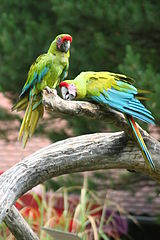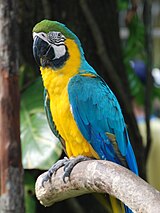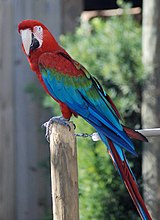Ara (bird)
| Ara | |
|---|---|

| |
| Blue-and-yellow Macaw (left) and Green-winged Macaw (right) at Jurong BirdPark, Singapore | |
| Scientific classification | |
| Kingdom: | |
| Phylum: | |
| Class: | |
| Order: | |
| Family: | |
| Subfamily: | |
| Tribe: | |
| Genus: | Ara Lacepede, 1799
|
| species | |
|
see text | |
Ara is a Neotropical genus of macaws[1] with eight extant species and at least one extinct species.[2] The genus name was coined by French naturalist Bernard Germain de Lacépède in 1799. It gives its name to and is part of the Arini, or tribe of Neotropical parrots. The Ara macaws are large striking parrots with long tails, long narrow wings and vividly coloured plumage. They all have a characteristic bare face patch around the eyes. Males and females have similar plumage. Many of its members are popular in the pet trade, and bird smuggling is a threat to several species.
Taxonomy
For many years the genus Ara contained a number of other species. Three genera have been split out from the genus, Orthopsittaca, Primolius and Diopsittaca. Orthopsittaca and Diopsittaca are two monotypic genera that were morphologically and behaviourally different, whereas the three Primolius macaws are three smaller green macaws.
Species and subspecies

There are eight surviving species and one extinct species.[2] The last confirmed sighting of the extinct Cuban Red Macaw was in 1864 when one was shot. Several skins of the Cuban Red Macaw are preserved in museums, but none of its eggs have survived.[3]
The Ara genus is subdivided as follows:[2]
- Blue-and-yellow Macaw, Ara ararauna (Linnaeus, 1758)
- Blue-throated Macaw, Ara glaucogularis Dabbene, 1921
- Military Macaw, Ara militaris (Linnaeus, 1766)
- Great Green Macaw or Buffon's Macaw, Ara ambiguus (Bechstein, 1811)
- Ara ambiguus ambiguus (Bechstein, 1811)
- Ara ambiguus guayaquilensis Chapman, 1925
- Scarlet Macaw, Ara macao (Linnaeus, 1758)
- Ara macao cyanopterus Wiedenfeld, 1995
- Ara macao macao (Linnaeus, 1758)
- Green-winged Macaw or Red-and-green Macaw, Ara chloropterus Gray, 1859
- †Cuban Red Macaw, Ara tricolor Bechstein, 1811 (extinct: last known individual shot in 1864)[3]
- Red-fronted Macaw, Ara rubrogenys Lafresnaye, 1847
- Chestnut-fronted Macaw or Severe Macaw, Ara severus (Linnaeus, 1758)
- †Saint Croix Macaw, Ara autocthones Wetmore, 1937 (extinct, known from subfossil bones)
Hypothetical extinct species
Several hypothetical extinct species of the Ara genus have been postulated based on very little evidence. They may have been subspecies, or familiar parrots that were imported onto an Island and later presumed to have a separate identity.
- Martinique Macaw, Ara martinica (Rothschild, 1905)
- Red-tailed Blue-and-yellow Macaw, Ara erythrura (Rothschild, 1907)
- Lesser Antillean Macaw, Ara guadeloupensis Clarke, 1905
- Jamaican Green-and-yellow Macaw, Ara erythrocephala Gosse, 1847
- Jamaican Red Macaw, Ara gossei Rothschild, 1905
- Dominican Green-and-yellow Macaw, Ara atwoodi Clarke, 1905
Morphology and appearance
The Ara macaws are large parrots ranging from 46–51 cm (18–20 in) in length and 285 to 287 g (10 oz) in weight in the Chestnut-fronted Macaw to 90–95 cm (35–37 in) 1708 g (60 oz) in the Green-winged Macaw. The wings of these macaws are long and narrow which is typical for species of parrot which travel long distances in order to forage. They have a massive downward curved upper mandible and a patch of pale skin around the eye that extends to base of the beak.[1] The skin patch bears minute feathers arranged in lines that form a pattern over the otherwise bare skin in all species of the genus except the Scarlet Macaw in which the skin in bare. In most species the bill is black, but the Scarlet Macaw and Green-winged Macaw have a predominantly horn coloured upper mandible and a black lower one.
The colours in the plumage of the Ara macaws are spectacular. Four species are predominately green, two species are mostly blue and yellow, and three species (including the extinct Cuban Macaw) mostly red. There is no sexual dimorphism in the plumage, and that of the juveniles is similar to adults, although slightly duller in some species.[1]
Distribution and habitat

The Ara macaws have a Neotropical distribution from Mexico to Argentina. The centre of Ara distribution is the Amazon Basin and the Panama-Colombia border-region; each with as many as four species found together (marginally five where the Military Macaw approach the western Amazon). Seven species are found in Bolivia, but no single locality in that (or any other) country surpasses four species. The most widespread species, the Scarlet Macaw, is (or was) distributed throughout large parts of Central America and the Amazon. On the other hand the Blue-throated Macaw and the Red-fronted Macaw have tiny distributions in Bolivia. The overall range of many species and the genus as a whole has declined in historical times due to human activities. The Military Macaw is distributed from northern Mexico to northern Argentina, but the distribution is discontinuous, with populations in Mexico, a large gap, then a population in the Venezuelan Coastal Range and a population along the Andes from western Venezuela to northern Argentina. The Blue-and-yellow Macaw was expiated from Trinidad in the 1960s,[4] as well as retreating from northern Argentina, and several species apparently went extinct in the islands of the Caribbean.
The Ara macaws are generally fairly adaptable in their habitat requirements; this reaches its extreme in the Scarlet Macaw, which as suggested in its widespread distribution, uses most habitat types from humid rainforest to open woodlands to savannah. The only requirement is sufficient large trees, which is where they obtain their food and breeding holes. The other species are slightly more narrow in their habitat choices, but the need for large trees is universal. The Blue-throated Macaw generally inhabits forest "islands" in the savanna, and the Red-fronted Macaw prefers arid scrub and cactus woodland.
Within their range, birds may travel widely seasonally in search of food. They do not undertake large scale migrations, but instead more local movements amongst a range of different habitats.
Feeding and diet

Like all macaws and most parrots seeds and fruit are the major part of the diet of the genus Ara. The particular species and range of diet varies from species to species. Unlike many birds macaws are seed predators not seed dispersers, and use their immensely strong beaks to open even the hardest shells. Their diet overlaps with that of some monkey species; in one study of Green-winged Macaws in Venezuela they shared many of the same trees as bearded sakis, although in some cases they ate the seeds at an earlier stage of ripeness than the sakis, when they contained more poison.[5] In order to deal with the poisons seeds often have to protect them, macaws, like other parrots, consume clay which both releases minerals and absorbs toxic compounds from the gut.[6]
Breeding
Like almost all parrots, the Ara macaws are cavity nesters.[7] The majority of species nest in cavities in trees, either a live or dead. Natural holes in trees may be used, particularly those in dead trees, otherwise holes created by other species; in Mexico Military macaws still use the cavities excavated by the now critically endangered Imperial Woodpecker. In addition to nesting in trees the Military Macaw and Green-winged Macaw will also nest in natural fissures in cliffs. This nesting habitat is the only one used by the Red-fronted Macaws, as sufficiently large enough trees are absent in its arid range.[8]
Species
| Ara | |||
|---|---|---|---|
| Common and binomial names[9] | Image | Description | Range[7] |
| Great green macaw or Buffon's macaw (Ara ambiguus) |
 |
85–90 cm (33–36 in) long. Mostly green, red on forehead, green and blue wings[10] | Central and South America, from Honduras to Ecuador |
| Blue-and-yellow macaw or blue-and-gold macaw (Ara ararauna) |
 |
80–90 cm (31.5–35.5 in) long. Mostly blue back and yellow front. Blue chin and green forehead. The upper zone of the bare white skin around each eye extending to the beak is patterned by lines of small dark feathers. | Panama, Colombia through to south-central Brazil. Small introduced populations present in Puerto Rico and Miami-Dade County, Florida |
| Green-winged macaw or red-and-green macaw (Ara chloropterus) |
 |
90 cm (36 in) long. Mostly red, with blue and green wings. The bare white skin around each eye extending to the bill is patterned by lines of small red feathers. | South America, from Colombia through to northern Paraguay (formerly northern Argentina) |
| Blue-throated macaw (Ara glaucogularis) |
 |
75–85 cm (30–34 in) long. Blue upperparts and mostly yellow lowerparts, blue throat. Areas of pale skin on the sides of the face are covered with lines of small dark-blue feathers, with pinkish bare skin at the base of the beak.[11] | North Bolivia |
| Scarlet macaw (Ara macao) |
 |
81–96 cm (32–36 in) long. Mostly bright red, with red, yellow and blue in the wings. There is bare white skin around the each eye extending to the bill. | Mexico to Colombia and the Amazon Basin. |
| Military macaw (Ara militaris) |
 |
70 cm (28 in) long. Mostly green, red forehead[12] | Discontinuous distribution in Mexico and along the Andes from Venezuela to north Argentina. |
| Red-fronted macaw (Ara rubrogenys) |
 |
55–60 cm (21.5–23.5 in) long. Mostly green. red forehead and red patch over the ears, pinkish skin on the face, red at bend of wings, blue primary wing feathers[13] | Central Bolivia |
| Chestnut-fronted macaw or severe macaw (Ara severus) |
 |
46 cm (18 in) long. Mostly green, chestnut forehead, red at bend of wings | Panama and South America in the Chocó and Amazon Basin |
| †Cuban macaw (Ara tricolor) Extinct ca. 1885 |
 |
50 cm (20 in) long. Red forehead fading to orange and then to yellow at the nape of the neck, dark brown bill paler at the tip; orange face, chin, chest, abdomen and thighs; upper back mainly brownish red, and the rump and lower back blue; brown, red and purplish-blue wing feathers; upper surface of the tail was dark red fading to blue at the tip, and brownish red underneath.[3] | Extinct - formerly endemic on Cuba and probably also on Isla de la Juventud (previously called the Isle of Pines).[3] |
| †St. Croix macaw (Ara autocthones) Extinct |
 |
Only known from sub-fossil bones found at two archeological sites.[14] | Extinct - Saint Croix, U.S. Virgin Islands and central Puerto Rico |
Hypothetical extinct Ara
This article is missing information about Error: you must specify what information is missing.. (February 2009) |
| Hypothetical extinct species | |||
|---|---|---|---|
| Common and binomial names[15] | Image | Description | Range[15] |
| †Jamaican Green-and-yellow Macaw or Red-headed Green Macaw (Ara erythrocephala) Extinct |
 |
length unknown. Red head, bright green body, blue wings and greater coverts. scarlet tail and blue on top, whereas the tail and wings were intense orange-yellow underneath[16] | Jamaica |
| †Red-tailed Blue-and-yellow Macaw (Ara erythrura) Extinct |
 |
length unknown. Blue and yellow. Rothschild's book Extinct Birds (1907) of Ara erythrura shows the tail tipped with blue on the color plate, whilethe text described it as "entirely red."[17] | Jamaica or Martinique[17] |
| †Jamaican Red Macaw or Gosse's Macaw (Ara gossei) Extinct |
 |
length unknown. Similar to the Cuban Red Macaw. Major difference: yellow forehead[18] | Jamaica |
| †Martinique Macaw (Ara martinica) Extinct |
 |
length unknown. Blue and orange-yellow (saffron). Similar to Ara ararauna.[19] | Martinique |
See also
References
- ^ a b c Forshaw, Joseph M. (1981) [1973, 1978]. Parrots of the World (corrected second edition ed.). David & Charles, Newton Abbot, London. p. 368. ISBN 0-7153-7698-5.
{{cite book}}:|edition=has extra text (help); Unknown parameter|coauthors=ignored (|author=suggested) (help) - ^ a b c "Zoological Nomenclature Resource: Psittaciformes (Version 9.004)". www.zoonomen.net. 2008-07-05.
- ^ a b c d Fuller, Errol (1987). Extinct Birds. Penguin Books (England). pp. 148–9. ISBN 0670817972.
{{cite book}}: Check|isbn=value: checksum (help) Cite error: The named reference "Fuller1987" was defined multiple times with different content (see the help page). - ^ Oehler DA; Boodoo D; Plair B; Kuchinski K; Campbell M; Lutchmedial G, Ramsubage S, Maruska E and S Malowski (2001). "Translocation of Blue and Gold Macaw Ara ararauna into its historical range on Trinidad". Bird Conservation International, 11: pp 129-141 doi:10.1017/S0959270901000211
- ^ Norconk, M; Wertis, C & W Kinzey (1997) " Seed predation by monkeys and macaws in eastern Venezuela: Preliminary findings" Primates 38 (2): 177-184 doi:10.1007/BF02382007
- ^ Diamond, J (1999). "Evolutionary biology: Dirty eating for healthy living" Nature 400(6740): 120-121
- ^ a b Collar N (1997) "Family Psittacidae (Parrots)" in Handbook of the Birds of the World Volume 4; Sandgrouse to Cuckoos (eds del Hoyo J, Elliott A, Sargatal J) Lynx Edicions:Barcelona. ISBN 84-87334-22-9 pp.420-425
- ^ Lanning, D (1991) " Distribution and breeding biology of the Red-fronted Macaw". Wilson Bulletin 103 (3): 357-365
- ^ "Psittaciformes (Version 9.004)". Zoonomen: Zoological Nomenclature Resource. 2008-07-05.
- ^ "Species factsheet: Ara ambiguus". BirdLife International (2008). Retrieved 24 July 2008.
- ^ "Species factsheet: Ara glaucogularis". BirdLife International (2008). Retrieved 24 July 2008.
- ^ "Species factsheet: Ara militaris". BirdLife International (2008). Retrieved 24 July 2008.
- ^ "Species factsheet: Ara rubrogenys". BirdLife International (2008). Retrieved 24 July 2008.
- ^ Olson, Storrs L.; Edgar J. Máiz López (2008). "New evidence of Ara autochthones from an archeological site in Puerto Rico: a valid species of West Indian macaw of unknown geographical origin (Aves: Psittacidae)" (PDF). Caribbean Journal of Science. 44 (2): 215–222.
- ^ a b Rothschild, Walter (1907): Extinct Birds (Online-Version)
- ^ "Species factsheet: Ara erythrocephala". The Extinction Website (2008). Retrieved 4 October 2008.
{{cite web}}: Unknown parameter|dateformat=ignored (help) - ^ a b "Species factsheet: Ara erythrura". The Extinction Website (2008). Retrieved 5 October 2008.
{{cite web}}: Unknown parameter|dateformat=ignored (help) - ^ "Species factsheet: Ara gossei". The Extinction Website (2008). Retrieved 4 October 2008.
{{cite web}}: Unknown parameter|dateformat=ignored (help) - ^ "Species factsheet: Ara martinica". The Extinction Website (2008). Retrieved 5 October 2008.
{{cite web}}: Unknown parameter|dateformat=ignored (help)
